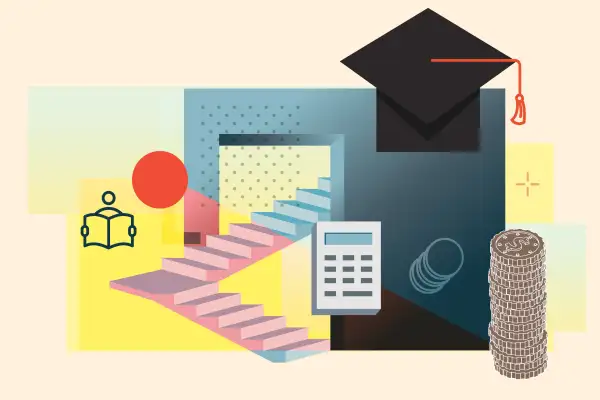Here's the Latest on Student Loans, Refinance Rates and More for June 17, 2020

Many colleges have finished disbursing their share of more than $6 billion in emergency financial aid, even as two lawsuits targeting the government's rules about the grants move forward.
Yet while the money has reached students, experts say it's far below the amount of help college students will need, and several recent surveys highlight how anxious students and parents are about paying for college right now.
Even before the pandemic and recession, finding ways to afford college was no easy feat: Tuition at public four-year colleges now averages more than $10,000 a year for in-state students, and that doesn’t include housing, books, and other living expenses. Nearly two-thirds of bachelor’s degree recipients have to use loans to help cover the bill.
This year, some students will be forced to rely on student loans more heavily to afford to go to college. Others may opt to attend a less expensive school or sit out a year to try to avoid debt.
Money’s roundup of college news, student loan advice, and interest rates can guide you through your decision.
College News and Student Loan Updates For 2020
A federal judge in California has blocked an Education Department rule that limits which students are eligible to receive relief grants provided through the CARES Act.
Tuesday's ruling granted a preliminary injunction in favor of the California Community Colleges, which represents the states 115 two-year colleges. It's the second ruling on the issue in a matter of days: On Friday, a Washington judge also blocked part of the rule.
The CARES Act, which was passed in March to provide economic relief for Americans amid the coronavirus pandemic, included a total of $14.3 billion for higher education, out of which $12.4 billion was split between grants for students and money for colleges to cover coronavirus-related expenses.
The implementation of the grants for students has been a mess, though. Many colleges made plans to disburse their portion of the money, but then had to stop after Education Secretary Betsy DeVos announced rules in April that limited the grants only to students eligible for Title IV financial aid.
Critics said that detail was not included in the law and doing so excluded international students and noncitizen students, including those participating in the Deferred Action for Childhood Arrivals (DACA) program. It also excludes students who didn't file financial aid forms, many student veterans, and more. (Read what Joseph Castro, president of California State University-Fresno, wrote about the Education Department's decision last month in Money.)
In California, U.S. District Court Judge Yvonne Gonzalez Rogers said the Education Department should not have excluded non-citizens from the emergency grants. In support of her decision, she wrote that the department included noncitizen students in their calculations for the amount of CARES money that would be distributed to colleges. U.S. District Court Judge Thomas O. Rice in Washington didn't go as far, but he did say colleges in that state should be able to give the grants to citizens who otherwise aren't eligible for financial aid.
Still, it's unclear how much the rulings will affect which students ultimately get grants. The judges' decisions only apply to colleges in Washington and California, and as we noted above, many colleges may have already given out all of their money. A recent survey found as many as nine in 10 colleges have already distributed the grants by last week, choosing not to wait for the outcomes of the lawsuits.
The Department of Education has said it will appeal the judges' rulings, according to Inside Higher Ed.
Current Federal Rates and What to Know
If you need to borrow for college, federal student loans should be the first option you explore, as they are easy to access. They don’t require credit checks and nearly any student in good academic standing can get them. Federal loans also offer more flexible repayment options than private loans. Annual borrowing limits range between $5,500 to $12,500, depending on your school year and dependency status.
Another great thing about federal student loans is that they take out the guesswork of figuring out your interest rate, since all applicants get the exact same pre-established rate for that particular year on that particular loan they applied for.
Interest rates for federal student loans are set every year using the results from the 10-year Treasury note auction each May. Those rates affect all federal student loans disbursed between July 1and June 30 of the upcoming year.
As a result of the economic fallout caused by the coronavirus pandemic, interest rates have fallen to record lows, which means that federal student loans for the upcoming 2020-2021 academic year will have the lowest rates in over a decade.
Here’s a breakdown of both the current and upcoming interest rates:
Federal Student Loan Rates: 2019-2020
- Undergraduate Direct Subsidized and Unsubsidized loans - 4.53%
- Graduate or Professional Unsubsidized loans - 6.08%
- Direct PLUS loans - 7.08%
Federal Student Loan Rates: 2020-2021
- Undergraduate Direct Subsidized and Unsubsidized loans - 2.75%
- Graduate or Professional Unsubsidized loans - 4.3%
- Direct PLUS loans - 5.3%
Compared to last year, students will be paying 1.78% less on interest, which could save you hundreds to thousands of dollars over the life of the loan. For example, if you took an undergraduate loan last year for $7,500 with a 4.53% interest rate, and a standard 10-year repayment plan, you will be paying around $1,840 worth of interest. If you take out that same loan this year, with the same repayment plan, but with the 2.75% interest rate, you’ll only be paying $1,087 worth of interest.
Private Student Loan Rates
Private student loans are an option to bridge the financial gap when you’ve exhausted all other types of financial aid avenues, including federal loans.
Martin Lynch, compliance manager and director of education at Cambridge Credit Counseling Corp.,says students should only use private loans as a last resort, and they should be as conservative as you possibly can with the amount you wish to borrow, and he suggests to only use them as a last resort.
“Always max out the federal loans first,” Lynch, who also serves the Financial Counseling Association of America’s board of directors, says.
Unlike federal loans, which only have fixed interest rates, private student loans offer both fixed and variable interest rates.The specific rate you get will depend on your (or your parents’) creditworthiness. With a fixed rate, payments stay the same over the life of the loan, while with a variable rate your payments may fluctuate based on current market conditions.
Most private student loans currently use the 3-month London Interbank Offered Rate, commonly known as “LIBOR,” as their baseline to set their interest rate ranges. The LIBOR usually follows the federal funds rate closely.
Last week, the Federal Reserve announced that the federal funds target rate will remain close to zero possibly until 2022. In other words, it is unlikely private loan rates will increase in the near future.
Here are today’s private student loan rates for undergraduate students from some of the nation’s largest lenders:
Wells Fargo
- Fixed: 4.78% - 10.97%
- Variable: 2.93% - 9.70%
SoFi
- Fixed: 4.73% - 11.46%
- Variable: 1.30% - 10%
Sallie Mae
- Fixed: 4.74%- 11.85%
- Variable: 1.25% - 9.44%
Discover
- Fixed: 4.49% - 12.39%
- Variable: 1.49% - 11.49%
College Ave
- Fixed: 4.64% - 13.24
- Variable: 1.74% - 12.23%
Refinancing Student Loans
If you already have private student loans, there’s probably never been a better time to refinance. With benchmark interest rates so low, your chances of securing a better interest rate are extremely high, especially if you have a good credit score of 720 or over, and a steady source of income.
Refinancing your private student loans can help you save money by lowering your interest rate. In some cases, you can also lower your monthly payment. If you have more than one loan, this can also be an option to help you consolidate multiple payments into a single one, plus it can help you release a cosigner.
When it comes to federal student loans, refinancing may not be the best option. “You would lose some of the benefits, like access to forgiveness programs,” says Brenda Hicks, director of financial aid at Southwestern College in Winfield, Kansas.
“It's really tough to beat the federal student loan rate, even if it's an unsubsidized loan. Federal student loans are at 2.75% right now, and that's incredible. I don't think you're going to be able to get a better rate than that, unless you have an incredibly good credit or a cosigner that's amazing,”she adds. However, Hicks says that for private or parent loans, refinancing could be a good move because rates in the private sector are at all-time lows.
Let’s say you currently owe $10,000 on a private student loan with a 9% interest rate and 5 years remaining on the repayment term. With that loan, you’ll end up paying the balance of $10,000, in addition to $2,455 worth of interest.
If you refinance that $10,000 with the same 5-year term, but with a 4% interest rate, you’ll end up paying less each month and only $1,050 worth of interest. In this case, refinancing saved you $1,400.
Here are today’s refinancing rates from some of the best-known refinance companies:
CommonBond
- Fixed: 3.2% - 6.43%
- Variable: 3.2% - 6.08%
Earnest
- Fixed: 3.45% - 6.68%
- Variable: 2.64% - 6.68%
SoFi
- Fixed: 3.20% - 6.44%
- Variable: 2.99% - 6.44%
More from Money:
With Interest Rates Near All-Time Lows, Here’s What to Know About Refinancing Your Student Loans
A Mistake Caused Credit Scores to Drop for Tons of Student Loan Borrowers. Here's How to Fix Yours

